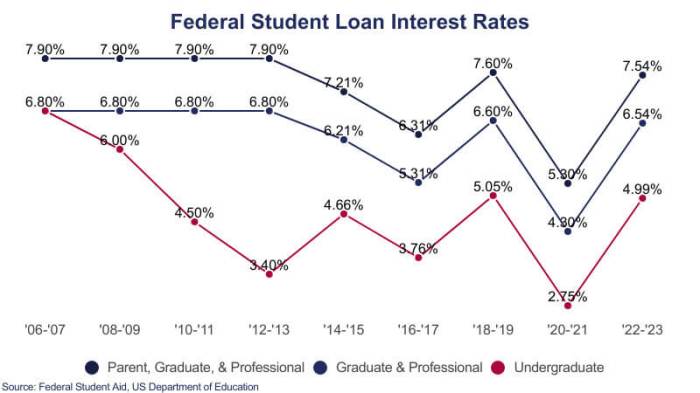
Navigating the world of student loans can feel overwhelming, especially when confronted with the complexities of interest rates. Understanding these rates is crucial for minimizing long-term debt and ensuring financial stability after graduation. This guide delves into the intricacies of student loan interest, empowering you to make informed decisions and secure the best possible terms for your financial future.
From the fundamental differences between fixed and variable rates to the strategies for securing lower interest payments, we will explore the various factors influencing your loan costs. We’ll compare federal and private loan options, analyze different repayment plans, and provide actionable steps to reduce your overall interest burden. Ultimately, our goal is to equip you with the knowledge to confidently manage your student loan debt and achieve your long-term financial goals.
Understanding Student Loan Interest Rates

Choosing the right student loan involves careful consideration of many factors, and understanding interest rates is paramount. Interest significantly impacts the total cost of your education, so it’s crucial to grasp how it works and how to minimize its effect on your finances. This section will clarify the different types of interest rates, factors influencing them, and provide illustrative examples.
Fixed vs. Variable Interest Rates
Student loans typically come with either fixed or variable interest rates. A fixed interest rate remains constant throughout the loan’s life, providing predictability in your monthly payments. Conversely, a variable interest rate fluctuates based on a benchmark index, such as the prime rate or LIBOR (although LIBOR is being phased out). This means your monthly payments could increase or decrease over time, depending on market conditions. Choosing between a fixed and variable rate depends on your risk tolerance and predictions about future interest rate trends. A fixed rate offers stability, while a variable rate might offer lower initial payments but carries the risk of higher payments later.
Factors Influencing Student Loan Interest Rates
Several factors influence the interest rate you’ll receive on your student loan. Your credit score plays a significant role; a higher credit score typically qualifies you for a lower interest rate. The type of loan also matters; federal student loans generally offer lower interest rates than private student loans. Furthermore, your chosen repayment plan can affect your overall interest cost, although it doesn’t directly change the interest rate itself. Longer repayment plans reduce monthly payments but lead to higher overall interest paid due to the extended repayment period.
Interest Rate Calculation and Accrual
Student loan interest is typically calculated daily on the outstanding principal balance. This daily interest is then added to your principal, a process known as compounding. Let’s consider an example: Suppose you have a $10,000 loan with a 5% annual interest rate. The daily interest rate is approximately 0.05/365 = 0.000137. On the first day, the interest accrued is $10,000 * 0.000137 = $1.37. This $1.37 is added to your principal, and the next day’s interest is calculated on $10,001.37. This compounding effect means that the longer you take to repay the loan, the more interest you will pay overall.
Comparison of Interest Rates from Various Lenders
The following table compares interest rates offered by hypothetical lenders. Remember that these are examples and actual rates vary depending on numerous factors.
| Lender Name | Interest Rate (%) | Loan Type | Repayment Terms (Years) |
|---|---|---|---|
| Lender A | 4.5 | Federal Subsidized | 10 |
| Lender B | 6.0 | Federal Unsubsidized | 15 |
| Lender C | 7.2 | Private | 5 |
| Lender D | 5.8 | Private | 10 |
Strategies for Reducing Interest Payments

Managing your student loan debt effectively requires a proactive approach to minimizing interest payments. Several strategies can help borrowers reduce their overall cost of borrowing, ultimately saving them significant money over the life of their loans. Understanding the nuances of each approach is crucial to making informed decisions.
Refinancing Student Loans
Refinancing involves replacing your existing student loans with a new loan from a different lender, typically at a lower interest rate. This can be a powerful tool for reducing your monthly payments and the total interest paid. However, it’s essential to carefully weigh the potential benefits against the risks.
Advantages of refinancing include potentially lower interest rates, leading to reduced monthly payments and faster loan repayment. It can also simplify your repayment process by consolidating multiple loans into a single one. Disadvantages include potentially losing access to federal loan benefits, such as income-driven repayment plans or loan forgiveness programs. Refinancing typically requires a good credit score and a stable income.
Income-Driven Repayment Plans
Income-driven repayment (IDR) plans are federal student loan repayment plans that adjust your monthly payments based on your income and family size. These plans offer lower monthly payments than standard repayment plans, potentially making them more manageable, especially during periods of lower income.
Advantages include lower monthly payments and potentially loan forgiveness after a certain number of years, depending on the specific plan and your income. Disadvantages include potentially extending the repayment period, leading to paying more interest over the life of the loan. Also, the amount of loan forgiveness may be taxed as income.
Potential Risks Associated with Refinancing Student Loans
Refinancing student loans carries inherent risks that borrowers should carefully consider. A significant risk is losing access to federal student loan benefits. Federal loans offer various protections and programs not available with private loans, including income-driven repayment plans and potential loan forgiveness programs. Furthermore, if your credit score deteriorates after refinancing, it could impact your ability to secure favorable terms on future loans. Another risk is locking into a fixed interest rate. If interest rates fall after refinancing, you won’t benefit from the lower rates.
Exploring and Comparing Refinancing Options
A step-by-step guide to exploring refinancing options involves several key steps.
First, check your credit score and report. Lenders will use your credit score to determine your eligibility and interest rate. Next, research different lenders offering student loan refinancing. Compare interest rates, fees, and repayment terms from multiple lenders to find the best offer. Third, prequalify with several lenders to get personalized rate quotes without impacting your credit score. Then, carefully review the terms and conditions of each loan offer before making a decision. Finally, complete the application process with your chosen lender and finalize the refinancing. For example, a borrower with a 750 credit score might find interest rates ranging from 4% to 7%, depending on the lender and loan terms. A borrower with a lower credit score might face higher interest rates or even be denied refinancing.
Closing Notes

Successfully navigating the student loan landscape requires careful planning and a thorough understanding of interest rates. By understanding the nuances of fixed versus variable rates, comparing federal and private loan options, and strategically choosing repayment plans, you can significantly impact your long-term financial health. Remember, proactive research and informed decision-making are key to securing the best interest rate and minimizing the overall cost of your student loans. Take control of your financial future by applying the strategies Artikeld in this guide.
FAQ Explained
What is the difference between a fixed and variable interest rate on a student loan?
A fixed interest rate remains constant throughout the loan’s life, providing predictable monthly payments. A variable rate fluctuates based on market indices, leading to potentially lower initial payments but increased uncertainty over time.
Can I refinance my student loans to get a lower interest rate?
Yes, refinancing can potentially lower your interest rate, but it involves replacing your existing loans with a new one from a private lender. Carefully weigh the pros and cons, as refinancing might extend your repayment term or have other implications.
What is an income-driven repayment plan?
Income-driven repayment plans base your monthly payments on your income and family size. While payments are lower, you may pay more interest overall and extend the loan’s repayment period.
What happens if I default on my student loans?
Defaulting on student loans can severely damage your credit score, leading to difficulty securing loans, credit cards, or even employment in the future. It can also result in wage garnishment and tax refund offset.
